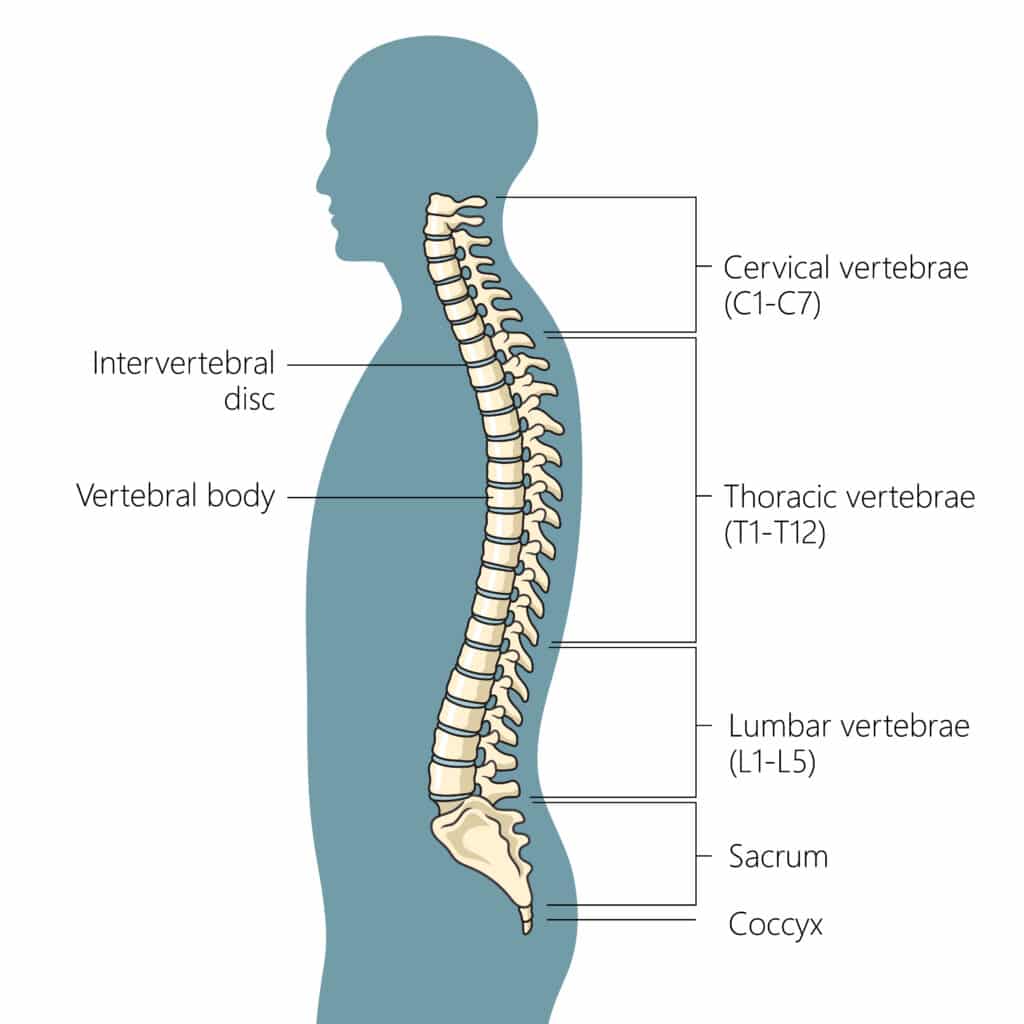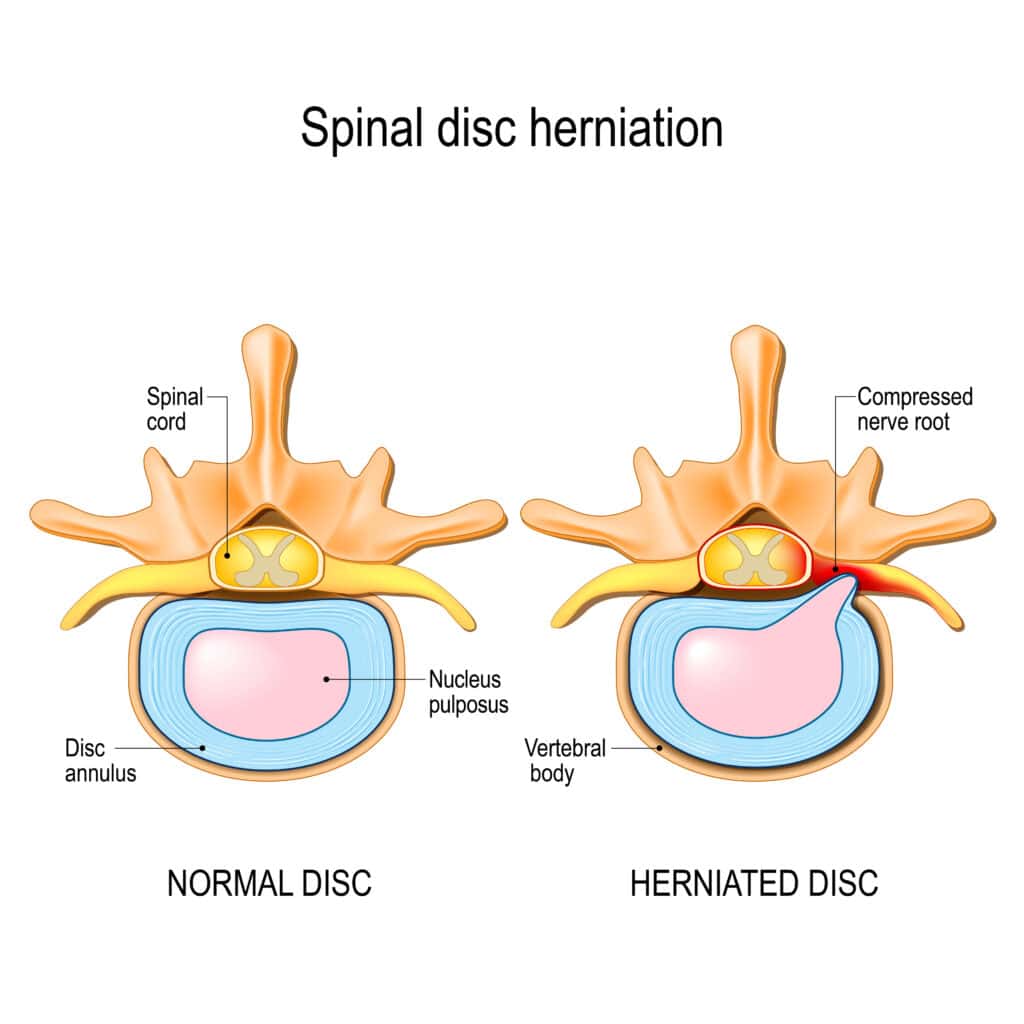How To Heal a Herniated Disc Quickly
If you’re suffering from a herniated disc, the pain is probably significant enough to get you wondering how to heal a herniated disc quickly. You’ll be relieved to know many people can use simple self-care treatments at home to lessen the pain in a matter of days and make a near-full recovery in just a handful of weeks.
Spinal Cord Anatomy

The spine is made of 24 movable bones called vertebrae plus nine fused bones that make up the sacrum and coccyx. Each vertebra is separated by a shock-absorbing disc that prevents the bones from rubbing against each other. The tough outer portion of these discs is called the annulus, and the gel-filled interior portion is the nucleus. Each disc also has a pair of nerves called nerve roots that leave it and branch out to your body. They act as messengers, relaying sensations and controlling movement.
A herniated disc is a condition wherein the gel-like center of an intervertebral spinal disc ruptures through a weak or torn spot in the tough, fibrous outer wall. The interior gel portion of the disc irritates your spinal nerves, causing them to become swollen and inflamed. The most common cause for this is aging, but it may also occur due to traumatic injury or improper lifting.
Cervical Disc Herniation

Also called a slipped disc, the most common place for a herniated disc is the lower back (the lumbar region). Herniated discs also often affect the neck (the cervical region). The cervical spine region supports your head, allowing it to bend and rotate.
Herniated discs can put pressure on nerves in the spinal canal and cause temporary numbness, weakness, and pain. When a herniated cervical disc affects the nerves in the neck, shoulders, and arms, it’s called cervical radiculopathy. This pain may radiate down the arm and into the hand, but it usually resolves on its own.
If a cervical herniated disc compresses the spinal cord, you may have problems walking, muscle spasms, or urinary incontinence. This is called myelopathy, and it’s indicative of a bigger issue such as trauma, tumor, degenerative disease, or infection. Myelopathy can cause permanent nerve damage if not treated.
Herniated Disc Self-Care
Self-care for a herniated disc typically begins with rest and non-steroidal anti-inflammatory over-the-counter medications like ibuprofen, Aleve, or Motrin. Many spine care specialists also recommend physical therapy for the pain. As the herniation shrinks, the pressure and pain will lessen. These home treatments for a herniated disc typically provide at least some relief in a matter of days. Complete herniated disc recovery time generally takes about 6 weeks.
If you’re experiencing back spasms from a herniated disc, ask about a prescription for antispasmodics or using electrical muscle stimulation. You may also want a guided epidural steroid injection that places pain-relieving medication in the exact location of the herniation.
Your spine and nerve specialist may recommend ice/heat therapy, acupuncture or acupressure, dietary changes, or other non-surgical treatments to help you heal a herniated disc quickly.
Herniated Disc Exercises

Physical therapy and at-home exercises can help many people with herniated discs return to their normal routines. Your spine specialist or physical therapist can correct your lifting techniques if necessary. They may suggest orthopedics to help with your sitting or walking posture. Herniated disc stretches and strengthening exercises targeting your neck, shoulders, and arms can also be helpful. Patients with a herniated disc will want to make exercises for herniated discs a lifelong part of their wellness routines.
Herniated Disc Emergency Symptoms
Sometimes, herniated discs require emergency care. A rare condition called Cauda Equina syndrome can cause serious complications if not treated immediately. It is often caused by a lumbar disc herniation or rupture in the L4-5 or L5-S1 discs. Cauda equina presents as traditional back pain with sudden onset of numbness and inability to urinate. You may have searing pain in your lower back or buttocks, numbness in and around the inner thighs, and pain that travels down the back of the thigh and into the foot. Your leg or foot may feel weak, or you may be unable to move them. If you’re experiencing these symptoms, seek treatment immediately. You may need surgery to relieve the nerve compression and avoid paralyzation, impaired bladder or bowel control, loss of sexual functioning, and other problems.
Other issues such as infection, cancer, or spinal fracture can cause disc herniation and related long-term problems as well. If you have severe or ongoing back pain not relieved by conservative methods, see a pain management and spine care specialist.
Surgery for a Herniated Disc
If your herniated disc still hurts after a year, and your specialist has ruled out other causal conditions, you may need herniated disc surgery. There are several different types of surgery for a herniated disc, including anterior cervical discectomy and fusion (ACDF), posterior cervical discectomy, artificial disc replacement, and minimally invasive microendoscopic discectomy. Herniated disc surgery recovery time depends on the type of surgery performed.
If you have neck or back pain and would like to speak with a spine specialist, please comment below or contact us.
Leave a Reply